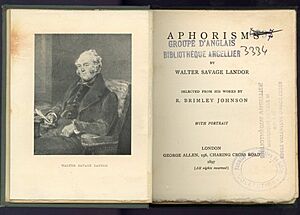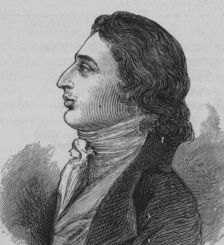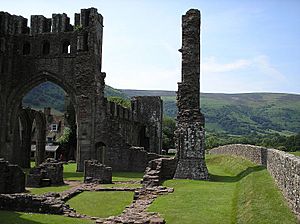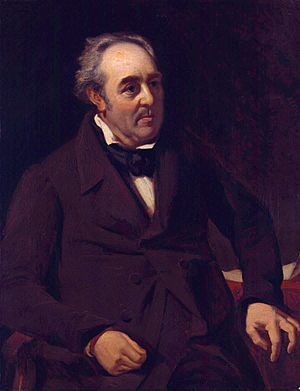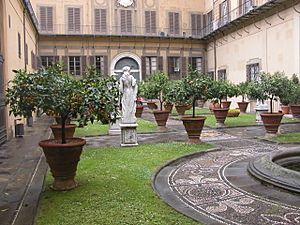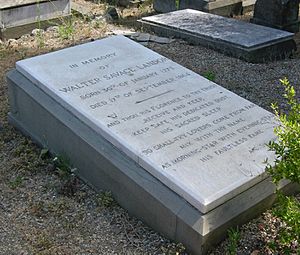Walter Savage Landor facts for kids
Quick facts for kids
Walter Savage Landor
|
|
|---|---|

Portrait of Walter Savage Landor
|
|
| Born | 30 January 1775 |
| Died | 17 September 1864 (aged 89) |
| Occupation |
|
| Alma mater | Trinity College, Oxford (no degree) |
| Literary movement | Romanticism |
Walter Savage Landor (born January 30, 1775 – died September 17, 1864) was an English writer, poet, and activist. He is best known for his prose work Imaginary Conversations and the poem "Rose Aylmer." While other poets and critics admired his work, he was not very popular with the general public.
Landor was known for his strong personality and lively spirit. He was passionate about freedom and fairness. He supported causes like those led by Lajos Kossuth and Giuseppe Garibaldi. He also became friends with and influenced younger writers like Charles Dickens and Robert Browning.
Contents
- Understanding Walter Landor's Works
- A Look at Walter Landor's Life
- Walter Landor's Early Years
- Life in South Wales and Gebir Poem
- Napoleonic Wars and Count Julian
- Llanthony and Marriage Life
- Florence and Imaginary Conversations
- England, Pericles and Writing
- Later Life and Return to Italy
- Artistic Recognition
- See also
Understanding Walter Landor's Works
Walter Landor lived a long life of 89 years. During this time, he wrote many different kinds of works. These can be grouped into four main types: prose, lyric poetry, political writings (including short, witty poems called epigrams), and works in Latin.
His prose and poetry are the most famous. Some critics call him a "poet's poet." This means other poets, like Yeats and Robert Frost, learned from his style. Landor's prose is best seen in his Imaginary Conversations. In these, he created talks between famous people from history. These characters ranged from ancient Greek thinkers to writers of his own time. Their conversations covered topics like philosophy, politics, and love. Landor was very good at writing dialogue. However, his plays were not as successful because he struggled with writing for the stage.
Landor also wrote beautiful and heartfelt poetry. His love poems were inspired by women he admired, like Ione and Rose Aylmer. He also wrote sweet poems about his sister and his children.
Throughout his career, Landor wrote for different newspapers and magazines. He wrote about topics he cared about, from politics to the unification of Italy. He was also skilled at writing epigrams. He used these short, sharp poems to make fun of politicians or others who upset him.
Landor wrote over 300 poems, essays, and political pieces in Latin. These are often overlooked today. Landor found Latin useful for expressing ideas that might have been too "unattractive" in English. It also helped him hide critical messages. Other scholars of his time thought his Latin work was as good as his English writing.
A Look at Walter Landor's Life
Landor's life was full of interesting events and challenges. Many of these problems were caused by his own actions. He had a stubborn nature and a quick temper. He also disliked being told what to do. These traits often got him into trouble. He was asked to leave Rugby School and University of Oxford. Sometimes, he was even asked to leave his family home.
He often argued with his political enemies. He also accidentally clashed with many important people. These included government officials, religious leaders, and lawyers. He usually found a way to get the better of them, sometimes with a clever remark years later.
Landor's writings sometimes caused legal problems because of what he said about people. Even his Latin writings in Italy didn't protect him from these issues. His friends often had to help him smooth things over or encourage him to be less extreme. His friends also worked hard to get his books published. Landor often felt publishers were unfair or that his work was hard to sell. He also had many legal fights with his neighbors in both England and Italy. The writer Charles Dickens even based a character in his book Bleak House on Landor's neighbor disputes.
Despite his troubles, Landor was described as "the kindest and gentlest of men" by the poet Algernon Charles Swinburne. He had many loyal friends who went to great lengths to help him. Swinburne also said that Landor was always ready to praise and encourage others. People who met him found him fascinating company. His great sense of humor, often shown in his loud laughs, helped him deal with life's difficulties. He cared deeply about children, animals, and flowers. This love shines through in his writings and in stories about his life.
Walter Landor's Early Years
Walter Savage Landor was born in Warwick, England. He was the oldest son of Dr. Walter Landor, a doctor, and Elizabeth Savage. His family was wealthy, and he was set to inherit their properties. His family had a strong literary background. They also supported the Whig political party, which opposed King George III and William Pitt the Younger.
Landor first went to a school in Knowle. Then he attended Rugby School. However, he disagreed with the headmaster's comments on his work and was asked to leave. Years later, Landor wrote about the headmaster in Latin, showing both praise and criticism. He later made up with him. After Rugby, he studied privately with a vicar named Rev. William Langley. Landor's strong opinions often caused problems at home. He was sometimes asked to leave when guests were expected. Once, he even threw a farmer into a river for complaining about his fishing.
In 1793, he went to Trinity College, Oxford. He was known for his rebellious style and for supporting French ideas of freedom. His tutor was impressed by him. But his time there was short. In 1794, he fired a gun at the windows of a political opponent who was making noise late at night. He was suspended for a year. Even though the school was willing to let him return, he refused. This led to an argument with his father, and Landor said he would leave home for good.
Landor then went to Tenby in Wales. He fell in love with a local girl, Nancy Evans, whom he called "Ione" in his early love poems. His father did not approve. Landor moved to London for a while. In 1795, he published a small book of English and Latin poems. He also wrote an anonymous political pamphlet criticizing William Pitt. Although Landor later called these "beginner works," Swinburne praised them. He said Landor showed great strength and skill for a young poet.
Landor eventually made up with his family, thanks to his friend Dorothea Lyttelton. He later said he would have married Dorothea if he had enough money. He did not choose a profession. His father gave him £150 a year, allowing him to live as he pleased.
Life in South Wales and Gebir Poem
Landor settled in South Wales but often visited his home in Warwick. In Swansea, he became friends with the family of Lord Aylmer, including his sister, Rose. Landor later wrote the famous poem "Rose Aylmer" about her. Rose Aylmer sailed to India in 1798 and sadly died of cholera two years later.
Ah, what avails the sceptred race,
Ah, what the form divine!
What every virtue, every grace!
Rose Aylmer, all were thine.
Rose Aylmer, whom these wakeful eyes
May weep, but never see,
A night of memories and of sighs
I consecrate to thee.

In 1798, Landor published Gebir, the work that made him famous. This long poem tells the story of a Spanish prince who falls in love with Queen Charoba of Egypt, his enemy. Southey, a famous poet, praised Gebir as "some of the most exquisite poetry in the language." He was eager to find out who the anonymous author was. Critics like Sidney Colvin compared parts of Gebir to the works of John Milton. However, William Gifford, a harsh critic, called it "a jumble of incomprehensible trash."
For the next three years, Landor lived an unsettled life, mostly in London. He became friends with the classics scholar Dr. Samuel Parr. Landor liked writing in Latin because it allowed him to express playful or critical ideas more privately. Latin writings were also not subject to libel laws in England at the time. Parr introduced Landor to Robert Adair, who asked Landor to write articles criticizing the government of Pitt.
In 1802, Landor visited Paris and saw Napoleon up close. This made him change his mind about his earlier praise for Napoleon in Gebir. That same year, he published Poetry by the Author of Gebir, which included the poems "Crysaor" and "The Phocaeans."
Landor's brother Robert helped him with corrections for Gebir. A second edition came out in 1803. Around the same time, Landor published the entire poem in Latin. This didn't make it more popular, but scholars like Parr and Swinburne admired it.
Landor traveled around England, often in debt. He spent a lot of time in Bath. There, he met Sophia Jane Swift. He called her Ianthe and wrote some of his most beautiful love poems to her. His father died in 1805, leaving Landor with his own money. He settled in Bath and lived in a grand style. In 1808, he met Southey in Bristol, and they became warm friends.
Napoleonic Wars and Count Julian
In 1808, Landor felt a strong urge to join the Peninsular War. At 33, he left England to volunteer in Spain against Napoleon. He offered money to help the cause. He was disappointed not to be in much direct fighting. He returned to England after the war ended. The Spanish Government thanked him, and King Ferdinand made him a Colonel. However, Landor gave back his commission when the King brought back the Jesuits. Back in England, he joined other writers like Wordsworth and Southey in criticizing the peace agreement.
His experience in Spain inspired his play Count Julian. This tragedy was based on the story of Julian, count of Ceuta. While it showed Landor's unique writing style, it was hard to follow because he wasn't skilled at writing drama. The story is complex, taking place after the defeat of the last Visigoth King of Spain. It teaches that one crime can lead to more crimes. Southey helped him get it published in 1812.
Llanthony and Marriage Life
Before going to Spain, Landor had bought Llanthony Abbey in Monmouthshire. It was a ruined old abbey. He sold his inherited property and convinced his mother to help pay for it. He wanted to be a good country gentleman. He planted trees and tried to improve the land. There is still an avenue of trees called "Landor's Larches" from his time.
In 1811, Landor met Julia Thuillier at a ball in Bath. He decided he would marry her. Julia was the daughter of a Swiss banker. They married on May 24, 1811, and lived at Llanthony Abbey for a while. Southey visited him there. However, Landor's peaceful life didn't last. For the next three years, he had many problems with neighbors, tenants, and officials. He also tried to publish an article about Charles Fox, but it was considered too critical and was not published.
His problems with neighbors often came from small arguments. He hired a lawyer who seemed to take advantage of him. His trees were pulled up, and his timber was stolen. He was even accused of causing a man's death. When he sued someone for theft, the lawyer insulted him. Landor often got revenge through his poems. He wrote a funny poem about his lawyers:
If the devil, a mighty old omnibus driver
Saw an omnibus driving downhill to a river
And saved any couple to share his own cab
I really do think t'would be Gabell & Gabb.
He wanted to become a local judge, but after an argument with the Duke of Beaufort, he failed. He wasted a lot of money trying to improve the land and help the poor. The final problem was when he rented his farmland to someone who didn't pay rent. After a costly legal fight, Landor had enough. He decided to leave England, leaving Llanthony to his mother and others he owed money to.
In 1814, Landor left England for Jersey. He had an argument with his wife and went to France alone. She later joined him in Tours. There, he met Francis George Hare, who would become a great help to him. Landor soon became unhappy in Tours and had big arguments with his landlady. In September 1815, he left with his wife and brother for Italy.
Florence and Imaginary Conversations

Landor and his wife settled in Como, Italy, for three years. Even there, he had problems. He was suspected of spying on Caroline of Brunswick, the Prince Regent's wife. In 1818, he upset the authorities with a Latin poem. He didn't realize that in Italy, unlike England, Latin writings were subject to legal action. He was ordered to leave Como. In 1821, he finally settled in Florence. After two years in the Medici Palace, he moved with his family to the Villa Castiglione. This was a very important time for his writing. He created some of his most famous works, the Imaginary Conversations. During this time, he became close friends with Lady Blessington.
The first two books of his Imaginary Conversations were published in 1824. More volumes followed in 1828 and 1829. These works criticized harsh rulers and supported ideas of freedom and republics.
Through these works, Landor gained a good reputation in literature, but not widespread fame. He had several arguments with the authorities in Florence. After a silver theft, police questioned him. He was labeled a "dangerous man," and the Grand Duke eventually banished him from Florence. However, the Grand Duke later took it good-naturedly. In 1829, Landor bought the Villa Gherardesca in Fiesole with help from a friend. Here, he had a dispute with a neighbor over water rights, which led to a lawsuit.
Landor was visited by writers like William Hazlitt and Leigh Hunt. He also became friends with Edward John Trelawny, whom he included in one of his Imaginary Conversations. His mother, with whom he always wrote kindly, died in 1829. Landor was happy at Villa Gherardesca for several years. He wrote books, played with his children, and enjoyed his gardens. Many people visited him, including Jane Swift (Ianthe) in 1829, which inspired him to write poetry again.
In 1832, a friend convinced him to visit England. He met many old friends, including Ianthe, Charles Lamb, Samuel Coleridge, and Southey.
When he returned to Fiesole, he found his children difficult to manage and hired a German governess. Back in Italy, he met Richard Monckton Milnes and Ralph Waldo Emerson. He worked on more conversations, including "Shakespeare's Examinations for Deer Stealing", "Pericles and Aspasia", and the "Pentameron". In 1835, Ianthe visited again with her half-sister. Landor's wife, Julia, became jealous, and they decided to separate.
England, Pericles and Writing
Landor was 60 years old when he returned to England alone in the autumn of 1835. He had money from properties in England. However, he gave most of it to his wife and son in Italy. His income was now much lower, and he faced money problems. He stayed with a friend for a few months and then in Clifton. "Pericles and Aspasia", which became one of his most loved works, was published in March 1836. It is written as an Imaginary Conversation and tells the story of Aspasia's love for Pericles through letters. This work is considered one of Landor's most joyful.
In 1836, Landor met John Forster, who later became his biographer. Landor also wrote more Imaginary Conversations. When a friend told him that one of his targets was over eighty, Landor joked, "The devil is older." He published several other works that year, including political essays and satires. He spent the winter in Clifton, where Southey visited him.
At the end of 1837, he published "Death of Clytemnestra" and "The Pentalogia," which contained five of his best short dramatic poems. His last work to be published was "Pentameron." Although it didn't sell well, his friends greatly admired it. In 1838, he moved to Bath and wrote three plays: "Andrea of Hungary", "Giovanna of Naples", and "Fra Rupert". These plays tell a historical story in a conversational style.
Landor's attempts to publish these plays were delayed by a dispute between his publisher and Charles Dickens. Even though these plays didn't become popular, Landor gained many admirers among his friends. Southey, whose mind was failing, still mentioned Landor's name. Landor often visited London, staying with Lady Blessington. He also became close to Mrs. Paynter and her daughter, Rose Paynter. Landor's letters and poems to Rose are considered some of his best.
Landor met Charles Dickens, and they enjoyed each other's company despite their age difference. Landor admired Dickens's books. Dickens even based the character Lawrence Boythorn in Bleak House on Landor. Landor was also the godfather of Dickens's son, Walter Landor Dickens. He also became friends with Robert Browning.
In 1842, Landor's son Arnold visited him. That year, Landor wrote a long essay on the Roman poet Catullus. In 1843, he mourned the death of his friend Southey and dedicated a poem to him. His children, Walter and Julia, visited him, and he published a poem for Julia.
By that dejected city, Arno runs,
Where Ugolino claspt his famisht sons.
There wert thou born, my Julia! there thine eyes
Return'd as bright a blue to vernal skies.
And thence, my little wanderer! when the Spring
Advanced, thee, too, the hours on silent wing
Brought, while anemonies were quivering round,
And pointed tulips pierced the purple ground,
Where stood fair Florence: there thy voice first blest
My ear, and sank like balm into my breast
For many griefs had wounded it, and more
Thy little hands could lighten were in store.
But why revert to griefs? Thy sculptured brow
Dispels from mine its darkest cloud even now.
And all that Rumour has announced of grace!
I urge, with fevered breast, the four-month day.
O! could I sleep to wake again in May.
The next year, his daughter Julia returned and gave him a dog named Pomero, who was a loyal friend.
Forster and Dickens often visited Bath to celebrate Landor's birthday. Forster helped Landor publish his plays and his 'Collected Works' in 1846. Landor often wrote for The Examiner on political topics. Forster didn't want some Latin poetry included, so Landor published his most important Latin work, 'Poemata et Inscriptiones', separately in 1847. One piece criticized King George IV.
Landor's dislike for the royal family is also shown in this famous poem:
George the First was always reckoned
Vile, but viler George the Second.
And what mortal ever heard
Any good of George the Third,
But when from earth the Fourth descended
God be praised the Georges ended.
In 1846, he also published the Hellenics, which included English translations of his Latin poems. That year, he met Eliza Lynn Linton, who became a famous novelist and journalist. She became a regular companion in Bath. Now over 70, Landor was losing many old friends and becoming ill more often. In 1849, on his 74th birthday, he wrote a well-known poem about himself:
I strove with none, for none was worth my strife.
Nature I loved, and, next to nature, Art;
I warm'd both hands before the fire of Life;
It sinks, and I am ready to depart.
He still had an active social life. Tennyson met him in 1850 and noted how Landor continued talking about Latin poets even when another guest fell downstairs and broke his arm. Thomas Carlyle visited him and described him as "a proud irascible, trenchant, yet generous, veracious, and very dignified old man."
In 1851, Landor wrote about Church reform. He published articles in various journals. That year, he learned of the death of his beloved Ianthe and wrote a tribute to her:
Sophia! whom I seldom call'd by name,
And trembled when I wrote it; O my friend
Severed so long from me! one morn I dreamt
That we were walking hand in hand thro' paths
Slippery with sunshine: after many years
Had flown away, and seas and realms been crost,
And much (alas how much!) by both endured
We joined our hands together and told our tale.
And now thy hand hath slipt away from mine,
And the cold marble cramps it; I dream one,
Dost thou dream too? and are our dreams the same?
In 1853, he published the collected Imaginary Conversations of the Greeks and Romans, which he dedicated to Dickens. Dickens's Bleak House came out that year, with the character Boythorn based on Landor. Landor also published "The Last Fruit off an Old Tree," which included new conversations, essays, and poems. Swinburne praised these works for their "noble and heroic pathos." Landor was also interested in world events, especially what he saw as unfair rule by Russia and Louis Napoleon. At the end of 1854, his beloved sister Elizabeth died, and he wrote a touching poem in her memory:
Sharp crocus wakes the froward year;
In their old haunts birds reappear;
From yonder elm, yet black with rain,
The cushat looks deep down for grain
Thrown on the gravel-walk; here comes
The redbreast to the sill for crumbs.
Fly off! fly off! I can not wait
To welcome ye, as she of late.
The earliest of my friends is gone.
Alas! almost my only one!
The few as dear, long wafted o'er,
Await me on a sunnier shore.
In 1856, at 81, he published Antony and Octavius: Scenes for the Study and continued writing Imaginary Conversations.
Later Life and Return to Italy
In early 1857, Landor's mind began to weaken, and he got into some difficult situations. He was involved in a court case and was insulted by a lawyer. He also got caught in an argument between two women he knew. He gave one of them, Geraldine Hooper, £100. She then gave half to the other woman, Mrs. Yescombe. They argued, and Mrs. Yescombe made false accusations against Hooper. Landor angrily wrote a pamphlet that was considered legally problematic. His friend Forster convinced him to apologize. In 1858, he published a collection called "Dry Sticks Fagoted by W. S. Landor," which contained more critical writings that led to further legal issues.
In July of that year, Landor returned to Italy for the last six years of his life. He was advised to give his property to his family, as he now depended on them. He hoped to live with his wife and children again, but they were not welcoming. He spent ten unhappy months at his villa, often fleeing to Florence, only to be brought back. On his last escape, he took refuge in a hotel with little money. Robert Browning, who was living in Florence, found him. Browning helped him get money from his family and settled him first in Siena and then in Florence.
Landor worked on new editions of his books and was interested in the unification of Italy. He wrote often to Eliza Lynn Linton and decided that any money from his book sales should go to help Garibaldi's soldiers. Anthony Trollope visited Florence with an American girl, Kate Field, who became Landor's student. He was still charming and full of literary interests. He taught Kate Field Latin, recited poetry, and wrote some last conversations.
In 1861, Browning left Italy after his wife died. Landor rarely left his house after that. He was often irritable. He worried about his picture collection and his grave, hoping to be buried near Bath. He published some Imaginary Conversations in 1861-62 and a last book, "Heroic Idyls," in 1863. Swinburne described this as the work of a genius who, at 88, had lost none of his power.
Forster's refusal to publish more about the legal case had strained their friendship, but they wrote to each other again before Landor's death. Almost the last event of his life was a visit in 1864 from the poet Swinburne, who came to Florence just to see him. On May Day in 1864, Landor told his landlady, "I shall never write again. Put out the lights and draw the curtains." A few months later, he died peacefully in Florence at 89. He was buried in the English Cemetery, Florence, near the tomb of his friend, Elizabeth Barrett Browning. A statue of his wife is also in the cemetery. In England, a memorial bust of Landor was placed in the Church of St Mary's, Warwick. Later, his Villa Gherardesca in Fiesole became the home of an American scholar, who renamed it the 'Villa Landor'. Landor's grandson was the writer and explorer Arnold Henry Savage Landor.
Landor was a close friend of Southey and Coleridge. His relationship with Wordsworth changed over time. Lord Byron often made fun of him. Although Landor didn't have much good to say about Byron when he was alive, he praised him as a hero after his death. He also greatly admired the dramatic works of his brother Robert Eyres Landor.
Artistic Recognition
A sculpture of Landor from 1828 by John Gibson is kept in the National Portrait Gallery, London.
|
See also
 In Spanish: Walter Savage Landor para niños
In Spanish: Walter Savage Landor para niños
- List of Landor's Imaginary Conversations


